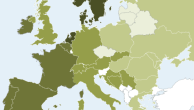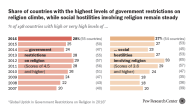This report brings together analysis of survey and demographic data from various previously published Pew Research Center reports. It also includes new analysis of the religious beliefs and practices of Orthodox Christians in Ethiopia and historical data on the distribution of Orthodox Christians, Catholics and Protestants around the world.
Attitudinal data was collected through nationally representative surveys conducted in various countries. Demographic data is compiled through analyses of censuses, large surveys and other sources.
Survey methodology
The report combines data from several Pew Research Center surveys. Short summaries of the methodologies used in each survey, along with links to the related reports and detailed methodologies, can be found below.
“Religious Belief and National Belonging in Central and Eastern Europe”
Data for Armenia, Belarus, Bosnia, Bulgaria, Croatia, the Czech Republic, Estonia, Georgia, Greece, Hungary, Kazakhstan, Latvia, Lithuania, Moldova, Poland, Romania, Russia, Serbia and Ukraine are from a survey in Central and Eastern Europe conducted via face-to-face interviews under the direction of three research partners – Ipsos MORI, Institute for Comparative Social Research (CESSI) and Georgian Opinion Research Business International (GORBI). (Kazakhstan was not analyzed as part of the initial report, but is analyzed throughout this report.)
The survey, conducted between June 2015 and July 2016, is based on samples of noninstitutionalized adults ages 18 and older. In some instances, samples exclude minor segments of the population due to accessibility problems, security concerns, very low population figures in rural areas or costs. All samples are based on multistage cluster designs, which typically entailed proportional stratification by region and locality size or urbanity, selection of primary sampling units (PSUs) proportional to population size, and random selection of secondary and tertiary sampling points within PSUs.
Interview teams were assigned to designated random routes at the block or street level and followed predetermined skip patterns when contacting households. Within households, interviewers randomly selected a respondent by using a Kish grid (a random selection from a detailed list of all household members) or by selecting the adult with the next or most recent birthday. For each country, the data were weighted to account for different probabilities of selection among respondents. Where appropriate, data also were weighted through an iterative procedure to more closely align the samples with official population figures for gender, age, education, urbanity and region.
Detailed methodology: https://www.pewresearch.org/religion/2017/05/10/appendix-a-methodology-8/
U.S. Religious Landscape Study
Data for the U.S. are from the 2014 Religious Landscape Study – a nationally representative telephone survey conducted June 4 to Sept. 30, 2014, among a sample of 35,071 U.S. adults. Sampling was conducted through random-digit dialing, with approximately 60% of the interviews conducted with respondents reached on cellphones (n=21,160) and 40% on landlines (n=13,911). Interviewing was conducted in English and Spanish. The survey is estimated to cover 97% of the noninstitutionalized U.S. adult population; 3% of U.S. adults are not reachable by telephone or do not speak English or Spanish well enough to participate in the survey. Data collection was divided equally among three research firms – Abt SRBI, Princeton Survey Research Associates International (PSRAI) and Social Science Research Solutions (SSRS).
The weighting of the data ensures that all states are represented in their proper proportion in the national weighted estimates. The data were weighted to account for different probabilities of selection among respondents. The data were also weighted to demographic benchmarks for the population covered by the survey. Most of the demographic weighting parameters came from the Census Bureau’s 2012 American Community Survey (ACS) one-year estimates, which was the most current data source available at the time the data were weighted.
Detailed methodology: https://www.pewresearch.org/religion/2015/05/12/appendix-a-methodology-3/
Pew Research Center’s 2015 Global Attitudes Survey
Most of the data for Ethiopia are from Pew Research Center’s 2015 Global Attitudes Survey, conducted under the direction of PSRAI. Face-to-face interviews were conducted March 25 to April 17, 2015, with a nationally representative sample of adults ages 18 and older. The survey used a multistage area probability sample design with the PSUs stratified by region and urbanity. Individuals within households were selected using a Kish grid. The data were weighted by age and education.
Detailed methodology: https://www.pewresearch.org/methodology/international-survey-research/international-methodology/global-attitudes-survey/ethiopia/2015
“Tolerance and Tension: Islam and Christianity in Sub-Saharan Africa”
Some other data for Ethiopia are from Pew Research Center’s previously released survey report that analyzed religion in sub-Saharan Africa. Results for the survey are based on face-to-face interviews with adults ages 18 and older conducted under the direction of PSRAI. The sample was designed as a stratified random sample of all nine ethnically based states and two self-governing administrative areas of the country, proportional to population size and urban/rural population. The fieldwork was conducted from Jan. 22 to Feb. 1, 2009, and was designed to be nationally representative of the adult population.
Detailed methodology: https://www.pewresearch.org/wp-content/uploads/sites/7/2010/04/sub-saharan-africa-appendix-c.pdf
Methodology for demographic estimates
The demographic estimates in this report draw upon religious demography research conducted by Pew Research Center over nearly a decade, involving analysis of more than 2,500 data sources, including censuses, demographic surveys, general population surveys and other studies.
Estimates of the size of Christian traditions in 1910 are based on Pew Research Center analysis of data from the World Christian Database (WCD) of the Center for the Study of Global Christianity at Gordon-Conwell Theological Seminary. WCD estimates take into account anthropological and ethnographic studies, statistical reports from religious groups, and data from censuses and surveys. The WCD enumerates many categories of Christians, which researchers at Pew Research Center have aggregated into the categories of Catholic, Orthodox, and Protestant and other Christians.
Estimates of the 2010 worldwide population of Orthodox Christians were based on data from Pew Research Center’s 2011 report “Global Christianity – A Report on the Size and Distribution of the World’s Christian Population” and the 2015 report “The Future of World Religions: Population Growth Projections, 2010-2050.”
The 2011 study of global Christianity produced estimates of the size and share of the Catholic, Protestant, Orthodox and other Christian populations at the country, regional and global levels for the year 2010 (see Methodology).27 The 2015 report used data unavailable in 2011 (including results from the 2010 wave of global censuses) and updated estimates of the size and share of Christian populations (as well as other major religious groups) in each country in 2010, projecting these populations through to the year 2050 (see Methodology). The 2015 report does not provide detail on the size or characteristics of subgroups of Christians (e.g., Orthodox Christians) or of subgroups among other major religions because the detailed demographic characteristics (structure of religious populations by age and sex, age-specific fertility rates, patterns of religious switching and patterns of migration between countries) that the report is based upon were generally unavailable for religious subgroups in most countries.
To generate the 2010 Orthodox population estimates used in this report, the country-level shares of Orthodox Christians among all Christians reported in “Global Christianity” were multiplied by the updated size of each country’s Christian population reported in “The Future of World Religions.”
The primary sources used for each country are listed in an appendix of each report cited above.




